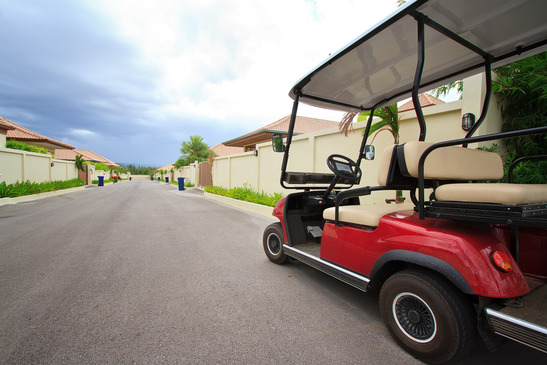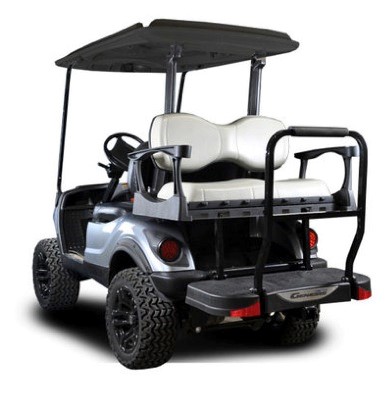Purchasing Golf Cart Insurance
Aug 5th 2016

Buying golf cart insurance is one of the simplest, smartest, and most important things you can do to protect your golf cart for the both the short term and the long term. You should be just as vigilant about purchasing golf cart insurance for your cart as you are for your car and home.

The golf cart insurance costs will depend on where and how you drive it, and what your primary usage for the cart is – that is, whether you mostly utilize it as an ATV, a riding mower, or even as a car to drive short distances around your neighborhood or local golf course.
Let’s break down the various types of golf cart usages and the best insurance for each.

Types of Golf Cart Use and the Best Insurance for Each

Just like with cars, it is easy to see there exist
various types of golf cart insurance based on how and how often you utilize
your cart. As with many other kinds of insurance, golf cart coverage and
protocol in the case of an accident also vary from state to state.
Basic Usage

In these instances, you are utilizing a golf cart as a riding mower. You usually only drive the golf cart around your backyard and property, or around your local golf course. The best type of insurance to purchase for this kind of usage is homeowner’s insurance, which often covers smaller, low-range vehicle use. Golf cart endorsements can cost you as little as $50 each year, making it both extremely afford
able and smart to keep your golf cart in good hands.

It is easy to insure for a riding mower or a vehicle you use as a
riding mower. There is no need to go through a formal registration process, nor do you require a driver’s license to operate the vehicle. However, it is important to keep in mind this type of insurance is limited. The vast majority of homeowner’s insurance policies do not, in fact, cover golf cart accidents unless they specifically occur within the boundaries of a designated golf course or the borders of your property (i.e., your backyard, front yard, or driveway).
Many insurance companies, however, will provide you with the option to take on a more comprehensive form of homeowner’s insurance that includes a segment called “golf cart endorsement.” Golf cart endorsement offers protection against physical destruction of the cart, liability, and even vandalism in your absence, or theft.
You will generally not be covered:
If you rent your car out to other drivers
Compete with it in recreational races
Are paid to transport goods and people for work or business
Do not drive inside the property borders or an official retirement or special access community
On or when traveling to and from a golf course
If you allow someone to drive the cart without a driver’s license
While none of these activities is prohibited, just know that accidents within these situations are unlikely to fall under the insurer’s umbrella.
Speed Modified

In these cases, you drive your golf cart at speeds of up to 25 miles per hour around the streets of your neighborhood or part of town. You are effectively utilizing the cart as a localized car. If you use your golf cart like this, the chances are that it comes packaged with some basic safety features, such as lap seat belts. The best type of insurance you can purchase for these is a particular type of auto insurance for golf carts and LSVs (Low-Speed Vehicles).

Many of these carts, as a matter of fact, can operate at anywhere from 20 to 35 miles per hour, as opposed to the standard maximum 15 mph. In fact, these LSVs can be driven on public streets featuring very slow speed limits, such as school zones, neighborhood residential streets, and more. In contrast to your typical old-school golf cart, LSVs must feature accessories such as headlights, brake lights, a working horn, full seat belts, a windshield, turn signals, rear view mirrors, tail lights, blinkers, and parking brakes.
As such, these particular carts are regulated and insured as motor vehicles, meaning they must all retain some form of auto insurance, and can only be driven and registered by drivers with valid licenses or driving permits. Legal insurance experts further recommend you look into purchasing an insurance policy that will offer more extensive coverage benefits, such as uninsured motorist coverage, medical payments coverage, or collision coverage.
All-Terrain Vehicle (ATV) Usage

In many cases, you may be using your cart as an ATV around your local neighborhood and city streets. More often than not, however, you only treat your cart like an ATV in the countryside or in rural areas where ATV use is already more common.

You also drive your cart out on the golf course if the situation calls for it. In this case, you will be better off purchasing a separate auto insurance policy for golf carts, or even umbrella insurance. Umbrella insurance policies offer a great deal of liability for you to lean on, well beyond what the other policies cover.
Furthermore, they provide coverage for amounts ranging from $1 million to as much as $5 million, at relatively affordable monthly and yearly premiums. Typically, these policies will not cover you for self-induced damage or injury at the lower levels, but if you are willing to shell out a few extra dollars per month, then you can receive coverage for almost any potential damage that may occur to your cart or the driver. You can purchase policies that provide coverage for:
| Collision Coverage This will ensure your cart is covered for damages or even parts replacements in case of an accident in which you collide with another vehicle. |
Uninsured Motorist Coverage This section of the plan replaces liability coverage. If the driver at fault in the accident is underinsured or uninsured, this segment would make sure you can recover with little loss or are in some way compensated for lost wages, resulting hospital bills, and psychological or physical suffering or pain. |
Annual Policies The chances are that if you own a golf cart, you will be looking at every possible moment to take advantage of it. This includes the occasional warm day in the winter. While many insurance policies are loath to cover you during the “off season” of golf – in other words, during the fall and winter – still more insurance plans offer annual policies. This ensures your cart is covered in case of an accident, even on those wild card summer-in-December days. |
Increased Limits Speaking of time and situational limitations on policies, you may prefer flexibility over price or most other factors. In this case, you should search for plans that offer the option to select the limits you would like placed on your liability, rather than having it chosen for you. |
Liability Coverage This particular coverage takes care of bodily injuries or harm caused by third parties. This also takes care of damage to your or other people’s property caused by driving with your LSV golf cart. Generally speaking, if you are looking to insure yourself against potential injury or property damage inflicted by you, you will need to purchase a plan that specifically offers protection for off-road vehicles. This is the broadest, most all-encompassing form of coverage in existence for golf carts. |
Medical Payments Coverage This type of coverage is self-explanatory; it takes care of much of the payments you will be making for hospital bills and medical care in the case of an accident that occurs while you are driving your golf cart. |

Other than Collision Coverage
This particular type of coverage can be filed under the “miscellaneous” section.
It offers protection against damages caused by elements out of your control, such as natural disasters, fire, vandalism, and even theft.

Steps to Insuring Your Golf Cart

Now that you are familiar with the various types of insurance you can purchase for your golf cart, you know which ones are right for you. The following is a step-by-step guide to help you purchase your golf cart insurance plan.
- Get a golf cart quote. This is
the first step to simply gauging how much it will realistically cost you to buy
an insurance plan for your cart, as well as what specific coverages and perks
come with the policies and companies you are researching. You can do this on
many insurance companies’ websites at no cost, or over the phone with an agent.
After all, not every business or insurance plan is going to have every single
benefit listed above, and those that do will usually be more expensive.
- To keep the process manageable and to
receive the most accurate estimate, keep your golf cart’s details – including
its make, year, serial number, and model – at hand, as well as the names and
driving records of the additional drivers you want to be listed under the
insurance. Furthermore, you will need to keep your insurance records handy,
including information on your present company and how long you have been
insured.
- Track down a good insurance agent.This is
the second and most important step that you will take. Finding an excellent
insurance agent who will advocate on your behalf and keep you informed is the
key to smooth sailing when purchasing your policy. Having a seasoned
professional to handle the paperwork and fine details will help to ensure you
receive the appropriate coverage.
- Make sure the agent and company
retain complete insurance coverage on LSVs and golf carts. Full coverage
encompasses damages for the cart itself, bodily injury liability,
uninsured/underinsured driver liability, medical payment coverage, and even PIP
or No-Fault insurance.
- Buy as much coverage as you can within your budget limit. The
uninsured motorist, liability, medical, you name it – if the plan offers it and
you can afford it, purchase it. It is always best to purchase enough coverage
that you, your cart, and your properties will be protected in the event of one
of the more common mishaps that can befall a golf cart.
- Get your vehicle listed. Ask your
insurance agent to have your golf cart listed – whether as an LSV, a Global
Electric Motorcar (GEM) cart, or a traditional golf cart – on your plan’s
policy declarations page.
- Register your vehicle with the Department of Motor Vehicles. This is
an important last step, particularly if you own a higher-powered golf cart or
LSV. Many state DMVs are beginning to mandate cart insurance before you are
allowed to register your vehicle, in a massive effort to reduce the number of
drivers without insurance (or with very minimal insurance) on American roads.
- Once you have gotten your vehicle listed by your insurance agent, you are well on your way to finally being ready to go. If your state keeps electronic rather than paper records, you will only need to give the name of your insurance company to the DMV.

Golf carts are some of the most versatile vehicles in existence. While their name would suggest otherwise, you can use golf carts for almost anything that requires movement. Whether it is a makeshift car on quiet neighborhood or rural roads, as an ATV when you are out muddin’ with your friends, as a way to transport items from one place to another, or even … well, as a golf cart!

Final Thoughts

No matter the use, it is always smart to make sure you are covered in the case of a major emergency – and regardless of how invincible or good of a driver you may think you are, it is always in your best interests to stay safe. Purchasing golf cart insurance is the best way to ensure that you will not be paying enormous bills out-of-pocket if you have an accident. Bundling your golf cart insurance with other insurance plans you have will save you money. Now that you know exactly what types of insurance you may need and how to procure it, you are golden for golf.







